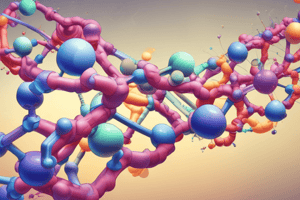Podcast
Questions and Answers
What is the primary product of the Sharpless Epoxidation process?
What is the primary product of the Sharpless Epoxidation process?
- Alkene
- Thiolate
- Epoxide (correct)
- Alcohol
The Sharpless Epoxidation leads to a mixture of enantiomers with a maximum enantiomeric excess of 90%.
The Sharpless Epoxidation leads to a mixture of enantiomers with a maximum enantiomeric excess of 90%.
False (B)
What is the mercapto group in thiols?
What is the mercapto group in thiols?
—SH group
Thiols can be oxidized to form __________.
Thiols can be oxidized to form __________.
Match the following terms to their correct descriptions:
Match the following terms to their correct descriptions:
What is the main purpose of using environmentally safe methods in green chemistry?
What is the main purpose of using environmentally safe methods in green chemistry?
Cr6+ oxidants can only oxidize primary alcohols to carboxylic acids.
Cr6+ oxidants can only oxidize primary alcohols to carboxylic acids.
What color change occurs when Cr6+ is reduced to Cr3+ during the oxidation process?
What color change occurs when Cr6+ is reduced to Cr3+ during the oxidation process?
In blood alcohol screening, the extent of the green color is correlated with blood alcohol __________.
In blood alcohol screening, the extent of the green color is correlated with blood alcohol __________.
Match the following oxidants to their description or characteristic:
Match the following oxidants to their description or characteristic:
What is the main product of oxidative cleavage of an alkene with conc. KMnO4 when there is one hydrogen on the carbon?
What is the main product of oxidative cleavage of an alkene with conc. KMnO4 when there is one hydrogen on the carbon?
Which oxidant selectively oxidizes secondary alcohols to ketones?
Which oxidant selectively oxidizes secondary alcohols to ketones?
PCC is used in an aqueous acid environment for the oxidation of alcohols.
PCC is used in an aqueous acid environment for the oxidation of alcohols.
Terminal alkynes produce only carbon dioxide when subjected to oxidative cleavage.
Terminal alkynes produce only carbon dioxide when subjected to oxidative cleavage.
What products result from the oxidation of ethanol (CH3CH2OH) using K2Cr2O7?
What products result from the oxidation of ethanol (CH3CH2OH) using K2Cr2O7?
What intermediate is formed during ozonolysis of alkenes?
What intermediate is formed during ozonolysis of alkenes?
The oxidation of alcohols typically converts them into _____ compounds.
The oxidation of alcohols typically converts them into _____ compounds.
Match the following reagents with their respective oxidation reactions:
Match the following reagents with their respective oxidation reactions:
Which reagent is commonly used to convert ozonides into carbonyl compounds?
Which reagent is commonly used to convert ozonides into carbonyl compounds?
Ozonolysis can lead to the formation of carbonyl compounds from all types of alkenes, including cyclic compounds.
Ozonolysis can lead to the formation of carbonyl compounds from all types of alkenes, including cyclic compounds.
What happens to the chromium species during the oxidation of alcohols?
What happens to the chromium species during the oxidation of alcohols?
Flashcards
Oxidative Cleavage of Alkenes with KMnO4
Oxidative Cleavage of Alkenes with KMnO4
Adding concentrated potassium permanganate (KMnO4) in a basic solution with heat to an alkene breaks the double bond. The products depend on the number of hydrogens on each carbon of the alkene.
Oxidative Cleavage of Alkenes with O3
Oxidative Cleavage of Alkenes with O3
Breaking the double bond of an alkene using ozone (O3). This forms carbonyl compounds and is also known as ozonolysis.
Ozonolysis
Ozonolysis
Oxidative cleavage of alkenes using ozone (O3).
Oxidative Cleavage of Alkynes with O3
Oxidative Cleavage of Alkynes with O3
Signup and view all the flashcards
Oxidation of Alcohols
Oxidation of Alcohols
Signup and view all the flashcards
KMnO4
KMnO4
Signup and view all the flashcards
O3
O3
Signup and view all the flashcards
Ozonide
Ozonide
Signup and view all the flashcards
Cr6+ oxidants
Cr6+ oxidants
Signup and view all the flashcards
Oxidation of 2° alcohols
Oxidation of 2° alcohols
Signup and view all the flashcards
Oxidation of 1° alcohols
Oxidation of 1° alcohols
Signup and view all the flashcards
Color change in Cr6+ oxidation
Color change in Cr6+ oxidation
Signup and view all the flashcards
Blood alcohol test
Blood alcohol test
Signup and view all the flashcards
Green Chemistry
Green Chemistry
Signup and view all the flashcards
Polymer-supported Cr3+
Polymer-supported Cr3+
Signup and view all the flashcards
Thiol oxidation
Thiol oxidation
Signup and view all the flashcards
Thiol synthesis
Thiol synthesis
Signup and view all the flashcards
Sharpless Epoxidation
Sharpless Epoxidation
Signup and view all the flashcards
SN2 reaction
SN2 reaction
Signup and view all the flashcards
Thiols (Mercaptans)
Thiols (Mercaptans)
Signup and view all the flashcards
Study Notes
Advanced Organic Chemistry - Chapter 1, Part C - MSC Students
- Course title: Advanced Organic Chemistry
- Chapter: 1, Part C
- Course participants: MSC Students
- Instructor: Dima Sabbah, Ph.D.
- Semester: Fall 2020
Oxidation and Reduction - Oxidative Cleavage of Alkenes with KMnO4
- Addition of concentrated KMnO4 in a basic solution with heat to an alkene results in cleavage between the double bond carbons.
- Products from the reaction depend on the number of hydrogens attached to each alkene carbon.
- One hydrogen on a carbon yields a carboxylic acid (RCOOH).
- Two hydrogens on a carbon yield carbon dioxide (CO2).
- One hydrogen on one carbon and one hydrogen on another yields a carboxylic acid and a carboxylic acid (RCOOH and R'COOH).
- No hydrogens on a carbon yields a ketone (R-CO-R).
Oxidation and Reduction - Oxidative Cleavage of Alkenes with O3
- Oxidative cleavage of an alkene with ozone (O3) breaks both sigma and pi bonds of the double bond, forming two carbonyl compounds (ozonolysis).
- The intermediate formed is called a molozonide, which rearranges to an ozonide.
- Zinc (in water) or dimethylsulfide is used to reduce the ozonide to carbonyl compounds.
Oxidation and Reduction - Oxidative Cleavage of Dienes or Polyenes
- Ozonolysis of dienes or polyenes leads to oxidative cleavage of all C=C bonds.
- When a double bond is part of a ring, oxidative cleavage opens the ring to form a single chain with carbonyls at the former double bond carbons.
Oxidation and Reduction - Oxidative Cleavage of Alkynes with O3
- Alkynes undergo oxidative cleavage of both bonds.
- Internal alkynes produce carboxylic acids.
- Terminal alkynes form a carboxylic acid and carbon dioxide (CO2) from the sp hybridized C-H bond.
Oxidation of Alcohols
- Primary alcohols can be oxidized to either aldehydes or carboxylic acids, depending on the reagent.
- Primary alcohols are oxidized to aldehydes using mild oxidizing agents such as pyridinium chlorochromate (PCC) in dichloromethane (CH2Cl2).
- Primary alcohols are oxidized to carboxylic acids using strong oxidizing agents like sodium dichromate (Na2Cr2O7) or potassium dichromate (K2Cr2O7) in the presence of sulfuric acid (H2SO4).
- Secondary alcohols are oxidized to ketones when the carbon containing the -OH group has one hydrogen.
- Tertiary alcohols are resistant to oxidation.
Oxidation of Alcohols - Additional Notes
- Oxidation of alcohols to carbonyl compounds typically involves a color change using Cr6+ oxidants which are reduced to Cr3+ products.
- Oxidizing agents like CrO3, Na2Cr2O7, and K2Cr2O7 are strong and non-selective oxidants, usually in the presence of aqueous acid (H2SO4).
- Pyridinium chlorochromate (PCC) is a more selective and milder oxidizing agent that is soluble in dichloromethane (CH2Cl2). This avoids the need for strong acid.
Oxidation of 2° Alcohols
- Any oxidizing agent containing Cr6+ can be used to oxidize 2° alcohols to ketones.
The Sharpless Epoxidation
- The Sharpless reagent consists of tert-butyl hydroperoxide, a titanium catalyst (usually titanium(IV) isopropoxide), and diethyl tartrate (DET).
- There are two different chiral diethyl tartrate isomers (+)-DET and (-)-DET, which affect the stereochemistry of the epoxidation product.
- In the Sharpless epoxidation, the double bonds of allylic alcohols are oxidized to epoxides.
- The reaction is enantioselective, meaning that one enantiomer is favored over the other, depending on the isomer of DET used.
The Sharpless Epoxidation - Determining Enantiomer Formation
- To determine the product enantiomer, draw the allylic alcohol on a plane, with the -OH group in the bottom right corner.
- (-)-DET adds the oxygen from above the plane.
- (+)-DET adds the oxygen from below the plane.
Thiols (Mercaptans)
- Sulfur analogues of alcohols are called thiols.
- The -SH group is called a mercapto group.
- Thiols are generally made using SN2 reaction with primary alkyl halides and sodium hydrosulfide.
Thiol Oxidation
- Thiols can be oxidized to form disulfides.
- Disulfides can be reduced back to thiols with a suitable reducing agent.
Green Chemistry
- Green chemistry aims for environmentally safe methods for synthesis.
- Methods using safer reagents, less solvent, and fewer by-products are preferred.
- Examples include using polymer-supported reagents to avoid harsh acids and using alternative oxidizing agents.
Studying That Suits You
Use AI to generate personalized quizzes and flashcards to suit your learning preferences.




